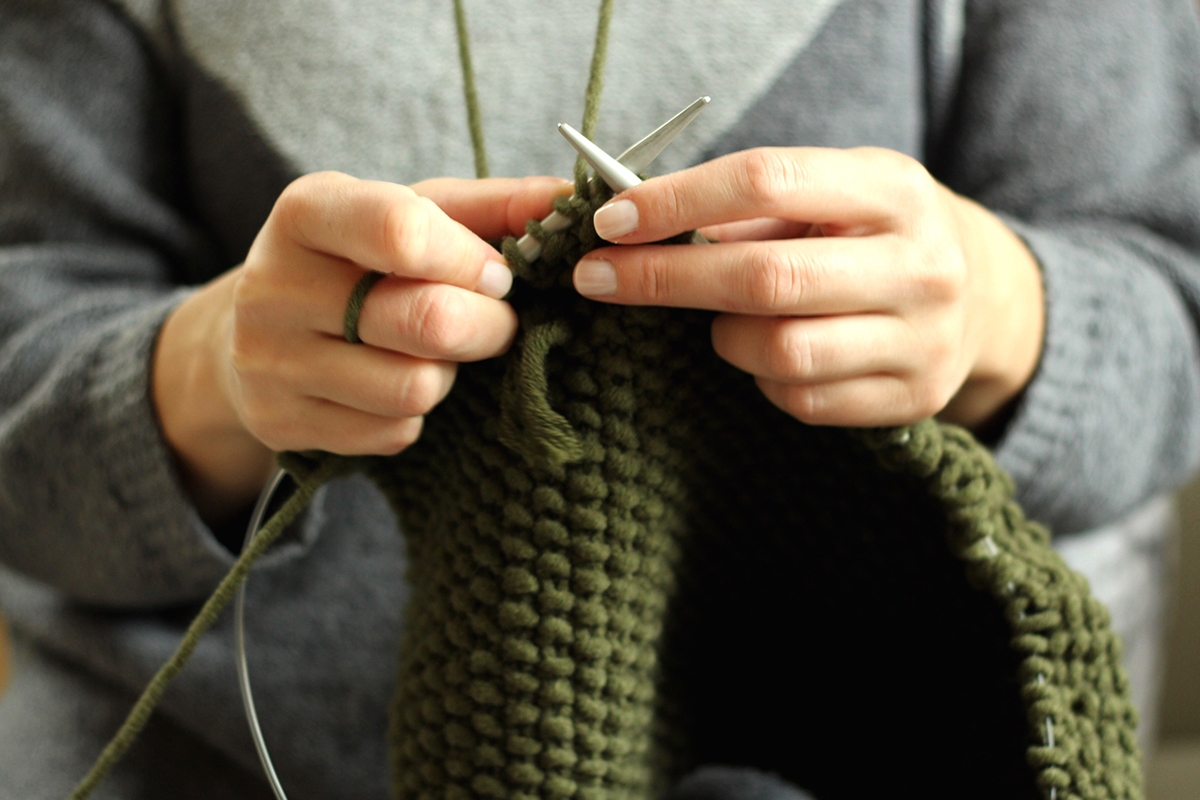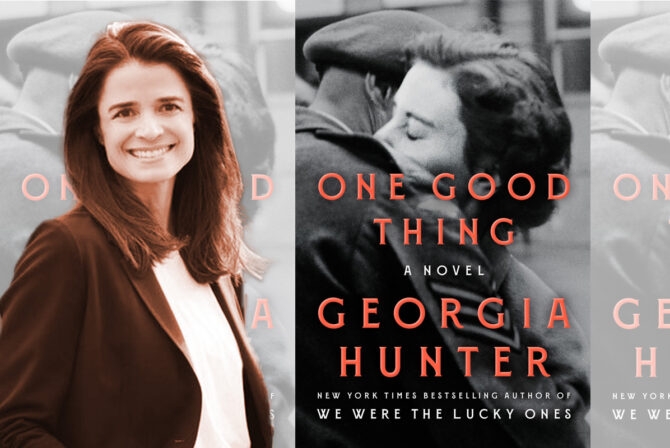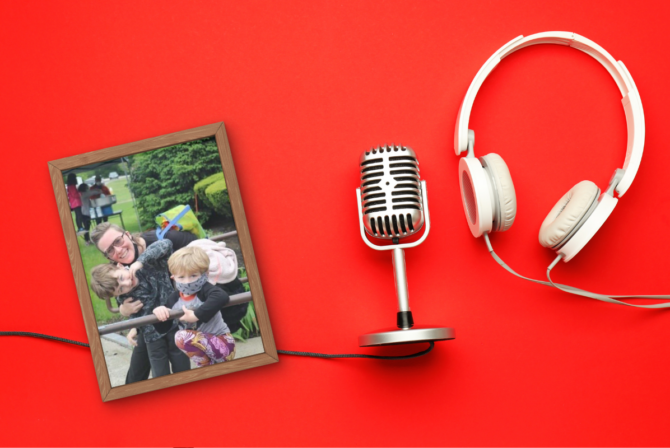Bubbe Esther, a devoted member of her synagogue and a lifelong member of Hadassah, was a prolific knitter and crocheter. Ever cost-conscious, she used acrylic yarn in the very 1970s hues of mustard yellow and avocado green and, with a considerable amount of love, she knit and crocheted afghans for all her children and grandchildren.
Perhaps her most memorable projects, however, were relegated to the bathrooms of her Century Village apartment in Deerfield Beach, Florida: Dolls with crocheted skirts that hid unsightly spare toilet paper rolls. They were quite the conversation starter for anyone who used the commode. Her bathrooms were on-trend, in avocado green and goldenrod yellow, and each featured a color-coordinated fancy doll that, from their perch atop the carpeted toilet tank, kept extra toilet paper out of sight.
My bubbe passed away when I was just 8, and while I never learned to knit from her, I’m convinced that she and my zayde, a tailor, planted the seeds for my love of textiles. These days, people knit for a host of reasons, and are well aware of the soothing powers of the craft. Knitting has been shown to lower blood pressure, reduce anxiety and depression, slow the onset of dementia and, of course, to build community. It is so much more than kitsch — it’s become a medium for tikkun olam, or repairing the world.
As a knitting teacher who has students and knitting friends who range in age from 6 to 96, I have witnessed the power of the modern “knitting circle” to build a better world. For me, the healing power started with a circle of one. For 20 years, I was a media executive in New York City, working with big publishing companies. I learned to knit on the side as a meditative, creative escape from the daily grind. At that time in my life, projects would lie unfinished and tucked away, like the sampler blanket — a classic way to learn new stitches — I started for my son, Sam, when he was in kindergarten. For many years, the half-finished blanket sat in a Ziploc bag on a high shelf in my closet.
But then, in early 2017, when Sam was halfway through eighth grade, he started to experience migraine-like headaches that would not break. After a visit with a neurologist, we learned he had a brain tumor. It was the worst day of my life. I can still remember taking the call from my husband while in the restroom at work: “He has a tumor and we need to go meet a surgeon,” he told me. “Today.”
Three weeks later, when Sam went in for surgery, I sat in the waiting room, idle and anxious. I thought about the blanket I started for him so many years earlier, and wished that I could wrap him in it as a sign of my love when words weren’t enough to ease his fear and unrelenting pain. After a five-year hiatus, I picked up my needles to finish his blanket during his three-month recovery period. Knitting is what saved me during that time.
Sam is now healthy, happy and about to embark on a new adventure in college — with the blanket in tow. While he will be leaving home, knitting has taken a permanent place in my life, and it’s become my mission to help others reap the benefits of the craft. My teaching practice began in the South Bronx. I serve on the board of Green Bronx Machine, a non-profit that brings a gardening curriculum to underserved communities, and I was thrilled to be asked to teach the children to knit. The young scholars in the flagship Green Bronx Machine program at Community School 55 loved the calm time spent knitting, and I brought more and more volunteer knitters to join the fun on a regular basis.
Once the pandemic hit, however, school pivoted to Zoom, and the knitting classes stopped. I desperately missed creating that connection with students, as well as the magical moments when they finished a row or their wide smiles when they completed a scarf.
Then, a neighbor asked me to teach her 12-year-old daughter, Lily, and some friends to knit. I jumped at the chance. We met in person, with masks and social distance in my backyard. Lily learned to knit with ease and determination, and her work was beautiful. I called her my “knitting ninja” because she would quietly start and finish projects with very little help. At the time, Lily was grieving her grandfather, who lost his life due to Covid complications, as well as the loss of her Aunt Hope, who died of cancer. Knitting became a source of inspiration and healing for Lily, who started her own mitzvah project, “Hats for Hope,” to honor her beloved aunt through monetary — and knitted — donations for cancer patients.
Knitting helped heal Lily through deeply personal losses, and I’ve also witnessed its power to provide comfort and shared connections across cultural, age and geographic boundaries. When we look for what we have in common and let knitting work its magic, incredible things happen. Knitting has this power to build relationships and bind people together across divides. That’s how my friendship began with Amal, a Muslim neighbor whom I also taught to knit.
Amal and I met last summer when she sought private knitting lessons. Over time, our relationship and conversations deepened — knitting removed the noise and allowed us to truly listen to each other’s perspectives about everything from her childhood living as a Muslim among Jews in Morocco to the tragic loss of my brother’s roommate years ago in a suicide bombing on a Jerusalem bus. This past spring, just after Ramadan, Amal invited me to her home for her trademark Moroccan mint tea. As we drank and talked about knitting, we shared our handcrafted works-in-progress — hers a crochet blanket, mine a neon pink-trimmed black-and-white poncho.
Amal told me that learning to knit gave her peace during the long months of the pandemic. When she was prevented from attending a funeral in Morocco, and from seeing her mom in Canada, the craft comforted her in unexpected ways. “Knitting saved me,” she says. “When I cried in your backyard, and you just listened and made me feel better, there was no religion, no race, nothing. Just pure humanity and pure love.”
Amal has taught me so much, too. That day we shared tea on her idyllic shaded deck, we spoke of our handwork and, yes, the war between Israel and Hamas. Our conversations always lead us to find the common thread we share: our love of fiber arts. “We pray for righteous people to guide our paths,” Amal said, as she told me how grateful she was to have me in her life through this difficult time. We Jews also pray to follow the paths of the righteous and I was struck by our shared use of the word.
As Amal prepared her family for a move, I helped her start two projects to ease her mind on the long family drive from New York to Florida. She gave me my own Moroccan tea set, and she taught me how to make her renowned mint tea. Made in an ornate silver teapot she bought from an importer in Queens, Amal uses loose leaf green tea, lots of sugar and a generous amount of fresh mint which she got from her “Savta,” an Israeli neighbor whom she refers to as the Hebrew word for grandma. And with that, the student became the teacher.
Perhaps — with so much about the pandemic and future uncertain — we all need a return to the basics. Maybe it’s time to re-learn the ways of our bubbes, who sat together and took time to make things by hand, home-brew traditional tea and build relationships that serve as the foundation to self care. Inspired by our ancestors before us, perhaps we can begin to repair the world, one stitch and sip at a time.








